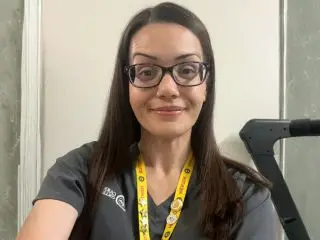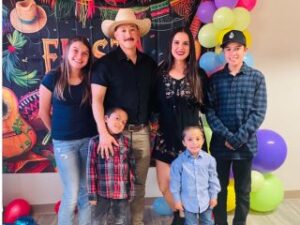 Misty Elom can trace her inspiration to become a Veterinary Technician back 25-years when she became fascinated by television’s Animal Planet. “Being an Emergency Vet seemed real cool and I thought taking care of animals would be a fun thing to do.” She completed Carrington College’s Veterinary Technology program in 2000 and in her mid-twenties was a Registered Veterinary Technician working full-time in that exciting field. Her career took her through many adventures with animals – even volunteering as veterinary staff for the annual 1,000-mile Iditarod Sled Dog Race in Anchorage Alaska. But she wanted to explore a different venue. ‘Teacher’ had a nice ring to it.
Misty Elom can trace her inspiration to become a Veterinary Technician back 25-years when she became fascinated by television’s Animal Planet. “Being an Emergency Vet seemed real cool and I thought taking care of animals would be a fun thing to do.” She completed Carrington College’s Veterinary Technology program in 2000 and in her mid-twenties was a Registered Veterinary Technician working full-time in that exciting field. Her career took her through many adventures with animals – even volunteering as veterinary staff for the annual 1,000-mile Iditarod Sled Dog Race in Anchorage Alaska. But she wanted to explore a different venue. ‘Teacher’ had a nice ring to it.
What took you from hands-on animal care to educator?
It was a natural evolution for me. I’d been doing this (animal care) for twenty-years and I felt I’d hit a wall in my career. Teaching presented itself to me and I thought I would give it a go. The selling point for me was I would be teaching at the same school I’d gone to and some of the instructors were still working there. That was positive testimony for the school.
What are your primary responsibilities as faculty for the Veterinary Technology (VT) program?
My primary responsibility is preparing VT students to sit for the Veterinary Technician National Examination. They have already completed four previous terms which include: how to restrain animals, large and exotic animal management, to fourth term learning to monitor animal anesthesia and surgery, radiology, as well as understanding state laws. They are also trained in dentistry, extractions, x-rays, lab procedures, surgery prep, preventative care, vaccines, and emergency care. We do it all. The Veterinary Technology program can be completed in as few as 19 months and graduates earn an Associate of Science degree.
What is the best thing about your role as faculty?
It’s when you’re communicating something, and you see it ‘click’ and students get it; they understand the concept. That’s huge. And when students start their externship in clinics to get their hands-on experience and see for themselves a concept in their book be put into practice – it all makes sense. And every time they do it, it will be less intimidating.
Why do you think the Veterinary Technology program is so effective and successful for students?
We instructors really love what we do. And by taking that passion and passing it on to students, it’s like….I have all this information to share with you and you want to hear it. We’re there to help animals (as Vet Techs). That’s what we love and if we can make you a better technician, you’re better for it.
What is your objective as a Veterinary Technology faculty member?
I want to give students the confidence that they can do this. And confidence is a safety thing. You’re dealing with animals that can’t use their words. You have to ‘read’ that pet on top of making them feel safe and secure. You’re going to do things they don’t like, like trim their toenails, taking temperatures and invading their personal space. Your confidence makes them feel less anxious. And knowing your job, pros and cons of medications and when to use them, will make doctors more confident in you.
Is there a struggle in your role to educate students to the reality of their career choice?
A lot of people think we play with puppies and kitties all day. But there’s a lot of math and science knowledge in this program. But we have student support tools, like tutors. Out in the real world, there’s also the emotional component of compassion fatigue in our field. We can get emotionally attached to pets we see every year to only, at some point, have to be a part of its death. It’s heart wrenching to grieve with a family then walk into the next room’s puppy exam and turn off your heartbreak. Or you see clients distraught because their pet has been hit by a car and can only be saved by surgery; then see a family struggle with the cost of that decision. Finances are a huge thing in animal care.
What motivates you to do your job well?
I tell my students this: ‘I want you to be the kind of technician that I want to work with. I want to walk into a practice and know you can be trusted. I want to see you self-motivated, confident and not afraid to ask questions. Because if you guess and get it wrong…that can be a pet’s life.
What is your current goal as an instructor?
My biggest goal is to make sure I’m conveying the information in the best, most effective, way I can. I use games like Trivial Pursuit – customized to veterinary medicine, anesthesia, radiology, dentistry. Roll the dice, land on a topic; kind of a review technique for the exam.
Describe this pivotal exam.
The Veterinary Technology National Exam (VTNE) is a 3-hour test of 170 multiple choice questions in the following categories: Pharmacy and Pharmacology, Surgical Nursing, Dentistry, Laboratory Procedures, Animal Care and Nursing, Diagnostic Imaging, Anesthesia, Emergency Medicine/Critical Care, and Pain Management/Analgesia. Additional information can be found at https://www.aavsb.org/vtne-overview/the-online-application Regarding testing, I tell my students “Trust your instincts, trust your knowledge. Tests can be intimidating, but you know more than you realize.”
What practical insights have you learned in your career that you pass along to your students?
Working with great technicians ups your game. Because I have worked in so many clinics, I have a more well-rounded idea of how things work. The main ingredient is always the animals. Because I love working with animals so much, I am continuing that influence by creating technicians that love animals, too. We’re putting good people out in the field to carry on that responsibility with passion. Carrington College prepares students to take appropriate certification and licensure exams related to their individual majors. The College does not guarantee students will successfully pass these exams or be certified or licensed as a result of completing the program.



